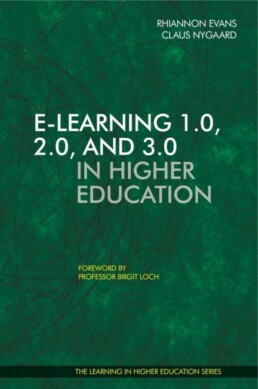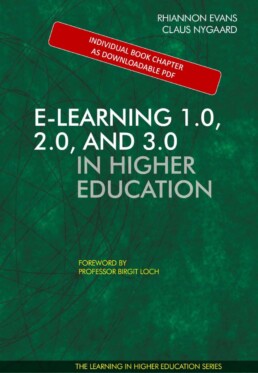E-learning in Higher Education. Three types of e-learning and their effect on student learning
Did you choose e-learning platform based on technological features, and did you forget to centre student learning in your implementation of it? Is your e-learning platform mainly used to distribute materials to students, while you keep teaching the same way you always did?
Then it might be time to rethink your e-learning portfolio by introducing student learning in the equation. Read on for inspiration as Professor Claus Nygaard, Director of the Institute for Learning in Higher Education introduces three types of e-learning and discuss their effect on student learning.
We are caught in a technology-trap when we implement e-learning in higher education
I started working with e-learning in 1988 developing learning software for the Danish primary school system. Since 1996, I have worked with e-learning in university settings. 32 years of involvement in practice has shown me that most often e-learning technology is picked following a one-sided focus on the technology itself.
The rule seems to be that
“10110110” (the binary numbering system)
overrules
“2+2=4” (the learning of students”).
E-learning in higher education tends to be a discussion of technology rather than a discussion of its outcomes.
We seem to be fascinated with all that technology can do, when we implement e-learning solutions. We are caught in a technology-trap. And despite having implemented e-learning technology, we continue to teach the same way we always did.
Does it sound familiar? Don’t worry, there are ways out of the technology-trap.
Ways out of the technology-trap
If you really wish to escape the technology-trap you need to bracket technology. You need to understand that technology in itself isn’t the important part. What is interesting is the relationship that is formed between student and technology. And the practice that is directed, encouraged, inspired or motivated as students relate to technology.
Your way out of the technology-trap begins as you start to understand students’ relation to technology and the practice fostered by this relation.
This I coin as the relational practice of e-learning (Nygaard, 2019).
I distinguish between three types of relational practice of e-learning:
1) distribution of information (e-learning 1.0);
2) dialogue about learning (e-learning 2.0); and
3) construction of knowledge (e-learning 3.0).
I have developed a typology for e-learning in higher education, which introduces the three types of relational practice we may form when using e-learning technology.
My aim with this typology for e-learning in higher education is to invite you to reflect more about your own choice of e-learning technology and the relational practice it forms.
E-learning 1.0: Distribution
- Use of e-learning:
- E-learning is used to distribute information to students
- Type of relational practice:
- Students become users who access information and learning materials.
E-learning 2.0: Dialogue
- Use of e-learning:
- E-learning is used to facilitate a dialogue between students (and teachers and other relevant peers)
- Type of relational practice:
- Students become learning partners who engage in learning dialogues
E-learning 3.0: Construction
- Use of e-learning:
- E-learning is used to enable the construction of new knowledge or innovation of new processes/products
- Type of relational practice:
- Students become learning innovators who construct new knowledge
Figure 1: E-learning in Higher Education. A typology. (Nygaard, 2019).
With this typology in mind, you can now initiate a discussion about the type of relational practice you aim to foster by your use of e-learning technology.
Do you design for distribution (e-learning 1.0)?
When you design for distribution, the e-learning technology is chosen based on its ability to serve as a technological extension of traditional face-to-face activities. Faculty will use the e-learning platform to distribute to students program/course descriptions, presentations given at lectures, assignments, quizzes, academic articles, links to relevant websites, videos, podcasts, etc. Information and learning materials distributed to support student learning.
Possible advantages of e-learning 1.0 (distribution):
- students have easy access to information and learning materials
- faculty can communicate to all students at the same time
- students’ learning can be scaffolded by a pre-designed learning journey
- reduced administration time and cost
Possible disadvantages of e-learning 1.0 (distribution):
- all students are spoon-fed with the same information and learning materials
- students learn within the frame of what is distributed (often students will ask: “Is this relevant for the exam?”)
- students become passive learners waiting for the next cue from the teachers
What are your own experiences with the use of e-learning technology as a medium to distribute information and learning materials to students? What kind of relational practice has e-learning 1.0 fostered at your university? What becomes the role of the faculty? How do students relate to technology, and how does it affect their practice as learners?
Make your own list of advantages and disadvantages of e-learning 1.0.
Do you design for dialogue? (e-learning 2.0)
When you design for online dialogue, the e-learning technology is chosen based on its ability to serve as an engaging online meeting place for students and faculty. Faculty design the e-learning platform so it invites students to become active in the online realm. It may be by having students design a personal avatar, make them engage in online discussion forums, arrange online video conferences, etc. Faculty will use the e-learning platform to guide students through relevant online exercises and facilitate online dialogues. And faculty will upload assignments which call for further student online engagement such as online collaborative work, peer-grading or peer-feedback.
Possible advantages of e-learning 2.0 (dialogue):
- as they engage in online dialogues students transform from individual learners to learning partners
- students become active learners expressing their own learning points in dialogues
- students take responsibility for their own learning and the learning of fellow students
- faculty can use the online domain to encourage to/or facilitate dialogues between all students at the same time
Possible disadvantages of e-learning 2.0 (dialogue):
- students who are less literate may hold back and become disengaged in dialogues
- dialogues may be linked to the predefined learning objective and thus lead to assimilative learning
- synchronous online dialogue is much more time consuming for students than asynchronous downloading of learning materials
What are your own experiences with the use of e-learning technology as a medium to foster dialogue? What kind of relational practice has e-learning 2.0 fostered at your university? What becomes the role of the faculty? How do students relate to technology, and how does it affect their practice as learners?
Make your own list of advantages and disadvantages of e-learning 2.0.
Do you design for construction? (e-learning 3.0)
When you design for collaborative construction of knowledge, the e-learning technology is chosen based on its ability to enable student’s to construct a meaningful learning journey. Here we design our e-learning platform so that it enables students to construct their own identity projects as students while they learn how to become future professionals. Faculty use technology which allows students to assess and document their own learning journey. This could be ePortfolios, personal wiki’s, academic blog’s, online collaborative tools, role-play games, etc.
Construction has the built-in requirement that students work to be innovative in the sense that they construct new knowledge. Usually, construction creates accommodative learning, because the requirement for innovation leads students to actively rearrange existing cognitive structures as they challenge their own presuppositions and creates new knowledge. Such processes of construction may be both individual and collective as faculty may design for online group work, peer-feedback, etc. As students document their learning journeys online, faculty can follow all students and give support.
Possible advantages of e-learning 3.0 (construction):
- students become learning innovators who construct new knowledge
- students become aware of their professional identity as they engage in the construction of their own learning journey
- students take responsibility for their own learning and support fellow students in their learning journeys
- faculty can follow and support the learning journeys of all students
Possible disadvantages of e-learning 3.0 (construction):
- students who are less literate may hold back and become disengaged in construction processes
- students who feel insecure about their own learning journey may be alienated
- collaborative construction of knowledge and the formation of personal learning journeys require much time and energy than online dialogue and distribution – this is the case for both students and faculty
What are your own experiences with the use of e-learning technology as a medium to foster knowledge construction? What kind of relational practice has e-learning 3.0 fostered at your university? What becomes the role of the faculty? How do students relate to technology, and how does it affect their practice as learners?
Make your own list of advantages and disadvantages of e-learning 3.0.
Maybe it’s time to revise your use of e-learning in higher education?
I have participated in a large number of technology-enhanced curriculum design projects. I have also supervised teachers who use e-learning as an integrated component in their curriculum.
Often I have found that e-learning decisions are taken with a focus on technology rather than learning. This has in many cases led to the implementation of stand-alone e-learning systems (CMS and LMS) which at the end of the day have been used as repositories for learning material only.
It is my argument that e-learning in Higher Education had been skewed towards e-learning 1.0 (distribution) with a little bit of e-learning 2.0 (dialogue) added to it. Rarely have I seen strategic use of e-learning 3.0 (construction).
It is my experience that when working with e-learning as a strategy for improving students’ learning outcomes, it is beneficiary to distinguish between the relational practice stemming from both faculty’s’ and students’ understanding of e-learning. This is the so because it enables a much more concrete dialogue about both learning goals and expected practices.
I believe that by using the typology of e-learning 1.0 (distribution), 2.0 (dialogue), and 3.0 (construction) it becomes much more tangible and clear to discuss the use of e-learning in university education. And to link that discussion to student learning.
Maybe it’s time to revise your own use of e-learning?
Reference
Nygaard (2019), E-learning as a strategy for improving university students’ learning outcomes. In Nygaard & Evans (2019), E-learning 1.0, 2.0, and 3.0 in Higher Education. Libri Publishing Ltd.


